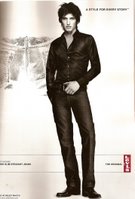This ad is pretty racist. I’m surprised to see it taking place today really. It actually took me several moments to figure out what it was advertising. By the Zen like pose that the female subject is in, I thought it might be for some sort of herbal product or yoga, (but that would be too obviously stereotypical). As it turns out, Michelle Wie (the model) is a professional golfer. The peacock-like feathers are actually golf clubs. She isn’t dressed like a golfer though, which somewhat confuses me as to the purpose of this ad. What I do notice here however, is that this ad is severely guilty of orientalism. It places an Asian woman in a pose of meditation, which sells the stereotype of Eastern culture being spiritual and commodifies it to sell this product. What also makes this ad to be highly exotic is its’ colourization. Note the use of oranges and yellows, both are visually appealing and have ties with Asian exoticism. There is also the use of objects in this ad that make it to be other-worldly. The mat which Wie is sitting on alludes to be a large lily pad, which is referential to the Lotus, which comes from Buddhism (also Zen/enchanting). The golf clubs behind her are structured to be like a peacock tail. Peacocks are not part of everyday Western culture, so they are more of a novelty to the audience that is receiving this advertisement.
All of these factors within this ad make it guilty of cultural appropriation. Sony is using Asian culture, and stereotypes related to it in order to sell its’ product to the Western market. It does not take into consideration the context of Zen, meditation etc, just the fact that it is appealing to a Western culture because it is different than what we have here. This ad is terribly stereotypical and degrading to Asian culture just for the sake of selling a camera. With this and the previous Playstation3 ad I’m wondering what Sony won’t do for a dollar…


















